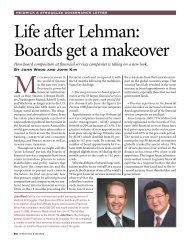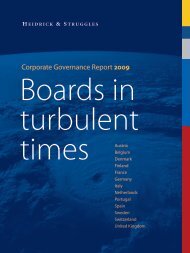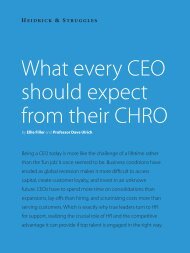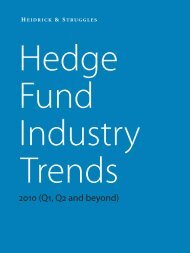The Chief Diversity Officer today - Heidrick & Struggles
The Chief Diversity Officer today - Heidrick & Struggles
The Chief Diversity Officer today - Heidrick & Struggles
Create successful ePaper yourself
Turn your PDF publications into a flip-book with our unique Google optimized e-Paper software.
<strong>The</strong> strategic scope of the role has increasingly meant<br />
working closely with the CEO and interacting with the<br />
Board. In the past, Board presentations from diversity<br />
officers were rare. Today, however, CDOs in leading<br />
companies appear before their Boards to assure them<br />
that the organization has satisfied legal concerns<br />
and is creating an inclusive culture by aligning talent<br />
management strategies. And because savvy Boards<br />
understand that embracing diversity and diverse teams<br />
leads to smarter decisions, they want to make sure<br />
that senior leadership in the organization is embracing<br />
diversity and inclusion, to know how diversity is being<br />
integrated into key business decisions, and to understand<br />
how diversity is impacting shareholder value.<br />
<strong>The</strong> scope of the strategic role also includes complex<br />
global components as the company operates in different<br />
cultures around the world, where diversity means different<br />
things to different people. In many European countries<br />
diversity is regarded less as an issue of ethnicity and more<br />
of an issue of gender and social class. Further, it is often<br />
positioned as a matter of equal opportunity. Although<br />
the business impact of diversity is often recognized, the<br />
business case for comprehensively pursuing it is a fairly<br />
new concept. For companies operating internationally, it<br />
is therefore essential to have a CDO who understands the<br />
challenges in differing locales and can develop a strategy<br />
that is appropriate for each and orchestrate them in the<br />
overall culture of the company.<br />
figure 3<br />
Logistics<br />
Technology<br />
Financial Services<br />
Business & Professional Services<br />
Life Sciences<br />
Consumer<br />
Industrial<br />
<strong>The</strong> best sectors for diversity in Fortune 500 companies<br />
source: <strong>Heidrick</strong> & <strong>Struggles</strong> KMC research, 2009<br />
4<br />
39<br />
74<br />
12<br />
30<br />
115<br />
216<br />
6 <strong>The</strong> <strong>Chief</strong> <strong>Diversity</strong> <strong>Officer</strong> <strong>today</strong>: Inclusion gets down to business<br />
Finding the right<br />
<strong>Chief</strong> <strong>Diversity</strong> <strong>Officer</strong><br />
<strong>The</strong> executives who are taking on the exacting challenges<br />
of diversity at leading companies <strong>today</strong> are themselves a<br />
diverse lot. Our analysis of the Fortune 500 found that 65%<br />
of diversity officers are female. In terms of ethnicity, 37%<br />
are African-American, 19% Caucasian, 4% Hispanic, 2%<br />
Asian, and 39% unknown. <strong>The</strong>ir educational backgrounds<br />
are varied, ranging from to MBAs to JDs, to undergraduate<br />
and graduate degrees in a wide range of disciplines. Of<br />
a sample of 182 diversity officers, the terminal degree for<br />
73 is a bachelor’s, for 87 it is a master’s, and for 22 it is a<br />
doctorate. Interestingly, there is little disparity between<br />
the percentage of these diversity officers developed<br />
internally versus those hired externally. In a sample of 205,<br />
we found that 54% were internal appointees and 46%<br />
were external hires.<br />
To determine the industrial sectors in which the efforts of<br />
these executives are meeting with the most success we<br />
used a proprietary <strong>Heidrick</strong> & <strong>Struggles</strong> assessment system<br />
to grade companies. Each company was assessed across<br />
five criteria on a scale of 1 to 5, with 1 being poor and 5<br />
being outstanding. Overall, the companies on the Fortune<br />
500 achieved an average score of 2.84. By sector, the top<br />
performer was Logistics (figure 3). Although the sample<br />
number of<br />
companies average rating score<br />
2.74<br />
2.61<br />
3.24<br />
3.2<br />
3.14<br />
3.1<br />
3.5
















